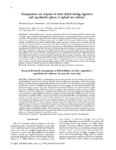Por favor, use este identificador para citar o enlazar este ítem:
http://www.alice.cnptia.embrapa.br/alice/handle/doc/874910Registro completo de metadatos
| Campo DC | Valor | Lengua/Idioma |
|---|---|---|
| dc.contributor.author | HEINEMANN, A. B. | pt_BR |
| dc.contributor.author | STONE, L. F. | pt_BR |
| dc.contributor.author | FAGERIA, N. K. | pt_BR |
| dc.date.accessioned | 2011-04-10T11:11:11Z | pt_BR |
| dc.date.available | 2011-04-10T11:11:11Z | pt_BR |
| dc.date.created | 2011-01-28 | pt_BR |
| dc.date.issued | 2011 | pt_BR |
| dc.identifier.citation | Scientia Agricola, v. 68, n. 1, p. 24-30, jan./fev. 2011. | pt_BR |
| dc.identifier.uri | http://www.alice.cnptia.embrapa.br/alice/handle/doc/874910 | pt_BR |
| dc.description | Water deficit is one of the most important abiotic stress limiting upland rice yield in the ?Cerrado? region of Brazil. Selecting drought tolerant cultivars is an important strategy to overcome this constraint. Two greenhouse experiments were conducted at Santo Antônio de Goiás, state of Goiás, Brazil, to compare the response of normalized transpiration rate (NTR) of three modern (BRS Primavera, BRSMG Curinga and BRS Soberana) and one traditional (Douradão) upland rice cultivars to soil water deficit during the vegetative and reproductive growth stages. This information will support breeding strategies to improve rice yield in a drought-prone target population environments (TPE) in Brazil. NTR and the total fraction of transpirable soil water (FTSW) were calculated, plotted and adjusted according to a sigmoid non-linear model. The p factor, defined as the fraction of available soil water that can be removed from the root zone before water deficit occurs, was calculated by assuming that it occurs when NTR is equal to 0.95. Modern cultivars had a higher value of p for the reproductive phase than for the vegetative phase. In addition, these cultivars are better adapted to express their potential yield in regions with low intensity and occurrence of water stress and the traditional cultivar is enable to better support adverse conditions of water stress. It can be concluded that there is need to precisely characterize drought patterns in TPEs. This information can focus the breeding program to improve drought tolerance in modern upland rice cultivars. | pt_BR |
| dc.language.iso | eng | eng |
| dc.rights | openAccess | eng |
| dc.title | Transpiration rate response to water deficit during vegetative and reproductive phases of upland rice cultivars. | pt_BR |
| dc.type | Artigo de periódico | pt_BR |
| dc.date.updated | 2011-07-25T11:11:11Z | pt_BR |
| dc.subject.thesagro | Arroz | pt_BR |
| dc.subject.thesagro | Oryza sativa | pt_BR |
| dc.subject.thesagro | Deficiência hídrica | pt_BR |
| riaa.ainfo.id | 874910 | pt_BR |
| riaa.ainfo.lastupdate | 2011-07-25 | pt_BR |
| dc.contributor.institution | ALEXANDRE BRYAN HEINEMANN, CNPAF; LUIS FERNANDO STONE, CNPAF; NAND KUMAR FAGERIA, CNPAF. | pt_BR |
| Aparece en las colecciones: | Artigo em periódico indexado (CNPAF)  | |
Ficheros en este ítem:
| Fichero | Descripción | Tamaño | Formato | |
|---|---|---|---|---|
| v68n1a04.pdf | 366.79 kB | Adobe PDF |  Visualizar/Abrir |









